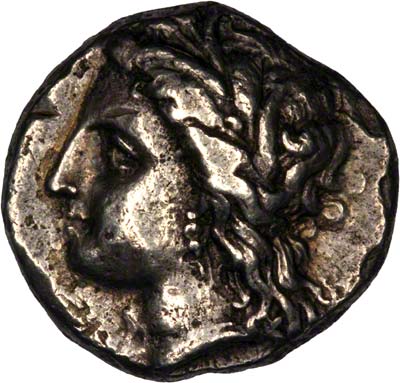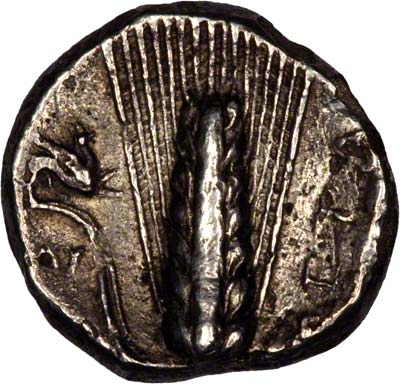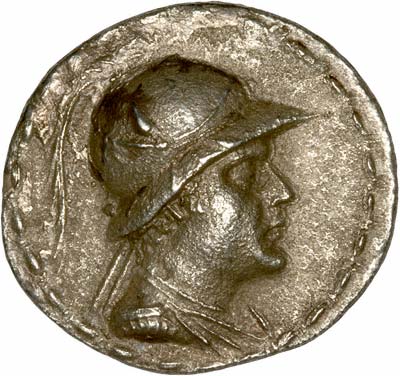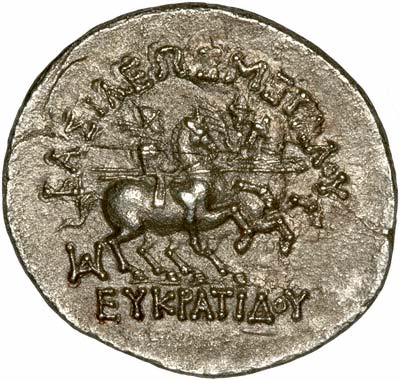| The Very Highest Quality Ancient Greek Coins |
| Ancient Greek Coins |
|
 |
 
|
|
|

|
|
|
Ancient Greek Coins
Ancient Greek coinage is traditionally divided into three main periods: The Archaic period (from the invention of coinage in Lydia to the outbreak of the first Greco-Persian war of 498 B.C.) The Classical Period, lasting up until the accession of Alexander the Great in 336 B.C. and finally, the Hellenistic Period, which lasted up until the Conquest of Egypt by the Romans in 30 B.C.
The Ancient Greeks were introduced to coinage by the Lydians, who were the first to invent coinage, in the 7th Century (Although the Chinese had already been issuing bronze imitation cowry shells as currency for some time before that). Alyates II, father and predecessor of Croesus, the famously wealthy King of Lydia had begun to issue electrum (a naturally occurring gold and silver alloy) staters (and fractional) coins issued in his name, having adopted the idea from local merchants.
Although Lydia eventually fell to the Persians, the idea of using pre-measured, standardised pieces of precious metal struck by the local government and used as a medium of exchange soon caught on in the region, and by the 6th-5th centuries B.C. the use of coins was widespread throughout the Ancient Greek world. By this time, the Athenian Tetradrachm (equal to four drachms) became the standard by which all other coins in the Hellenic world were based, with most of the Greek city-states and satrapies issuing coins of their own based on the Attic (Athenian) standard*, albeit with designs reflecting their country of origin, such as the owl, (representing Athens), the wheat sheaf (representing Metapontum) and so on. Other designs featured the issuing city's patron God, mythological creatures, and even puns relating to the name of the city (such as a Rose for Rhodes, after rhodon, the Greek word for 'rose')
With the conquests of Alexander the Great, the issue of 'Greek' style coinage ranged from Macedonia down into Egypt and as far east as India, and this continued long after the death of Alexander. Although the Roman conquest of most of the Hellenic world in the 2nd and 1st centuries B.C. is said to mark the end of period in which Ancient Greek Coinage was struck, greek-style denominated coinage actually survived for centuries into the Roman Imperial age, with provincial currency being issued in the Hellenic parts of the Roman Empire (roughly from the coast of the Adriatic, into Asia-Minor and around the Eastern Mediterranean region into Egypt) which was still based on Greek standards of obols, drachms and tetradrachms (For this reason, we have included Roman Provincial issues intended for circulation in the East in this section). These coins were issued in the name of the Roman Emperor, but during the third Century A.D. they were heavily debased compared to the time of the Athenian Empire or Alexander the Great. A tetradrachm of Diocletian for example, was smaller and made of billon (a very low grade silver alloy), whereas an Athenian 'Owl' or an Alexander the Great Tetradrachm was quite large and made of very fine silver. Following the currency reforms of Diocletian, the ancient system of Greek coinage came to an end.
Roughly speaking, Ancient Greek currency was divided into several main coin types: 6 bronze Obols made a silver drachm, two drachms made a silver stater, two staters made a silver teradrachm (or 'four drachms'). Other denominations which were fractions or multiples of these denominations were also minted. Occasionally, gold 'staters' were also minted, but the value of these coins tended to fluctuate between 20-28 silver staters, depending on the value of gold relative to silver, the latter of which was the currency standard of the day.
*The Attic Standard was equal to around 4.3g fine silver to the Drachm, or about 17.2g per Tetradrachm. Long before the hyperinflationary Roman debasement however, this standard was gradually reduced by some Hellenic states. Under the Ptolemaic dynasty of Egypt for example, the weight of a fine silver Tetradrachm fell below 14g.
Catalogue of Greek Coins for sale.
Order Form - UK
Order Form - USA
Order Form - EU
Order Form - Rest of World
Buying Coins
We also buy coins, please see our We Buy Coins page.
If you want to find the value of a coin you own, please take a look at our page I've Found An Old Coin, What's It Worth?
| ...at the Lowest Possible Price |
|
32 - 36 Harrowside, Blackpool, Lancashire, FY4 1RJ, England.
Telephone (44) - (0) 1253 - 343081 ; Fax 408058; E-mail: enquiries@24carat.co.uk The URL for our main page is: https://24carat.co.uk Web Design by Snoop |